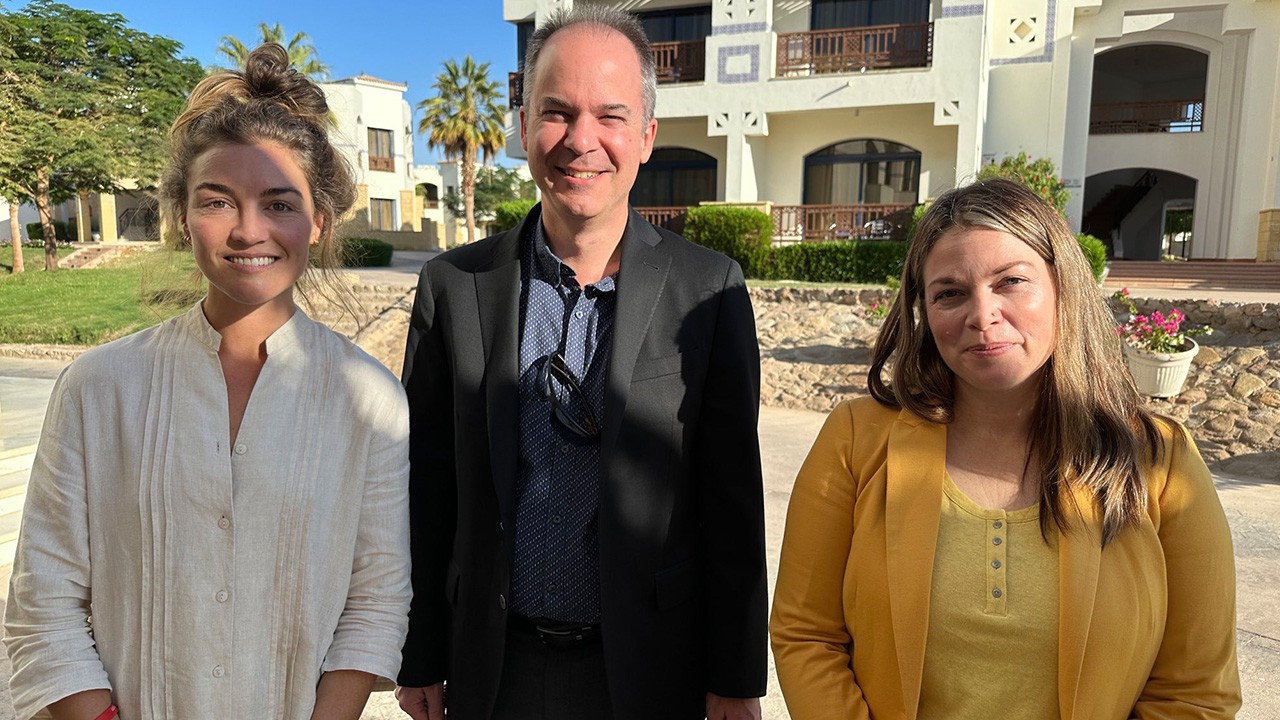
MY FIRST TIME AS A COP DELEGATE
I spent last week at COP 27 in Sharm El-Sheik, Egypt. It was my first time at a COP (the United Nations Climate Change Conference of the Parties), and the first time Simon Fraser University (SFU) has centrally organized a formal delegation. I have been to conferences before, but nothing like this. Rather than a single conference, it felt like three to four very large conferences superimposed. Thousands of government representatives in dark blazers carried out formal negotiations while intermingling with a very diverse crowd of thousands of “observers”. I chose the word “superimposed” above with some care—these were not parallel events or government officials surrounded by a sea of protesters. Observers provided serious and thoughtful content in a variety of forms—speeches, panel discussions, public art and protest—and the “parties” participated. While the parties were negotiating, the observers were invited into the rooms to take-in the deal-cutting discussions and processes adding a level of observational pressure to the negotiations. Each day I could move seamlessly back and forth between formal negotiating sessions, panel discussions with subject-matter experts from around the world in official side events, organized protests and many, many other fascinating unofficial events. (Well OK, it wasn’t seamless; finding the content I was looking for at a site designed for 44,000 delegates over two weeks created some...seams...but I generally got to where I was going.)
This COP was an “implementation COP”. Unlike Glasgow last year—at which governments made updated climate pledges—the focus of negotiations, and many of the side discussions this year was how to make the pledges a reality. As a COP hosted in Africa, there was a strong presence of African delegates and African perspectives about both adaptation and mitigation. Africa emits a very small fraction of the world’s greenhouse gases or GHGs (3-4%)—but the people of Africa suffer disproportionately from climate-induced effects. Damage and Loss discussions were prominent at this COP, and so were discussions of how to fund a green energy transition in Africa. By 2050, Africa is expected to be a literal powerhouse in the renewables space due to its excellent solar and wind resources. So, in addition to the nation-to-nation negotiations, bilateral deals were being struck between nations and banks, and between banks and major industry players to build infrastructure in Africa. However, an important part of the discussion in the sessions was about how we ensure that the resulting economic benefits accrue to Africans and that the implementation of this infrastructure be inclusive and just for Indigenous peoples, women, children and the poorest in each country, to avoid a repeat of the colonial past.
I thought the programming and discussions at COP 27 were fascinating—as an interested individual human, I certainly learned a lot. I think it is fair to say that the whole SFU team will be bringing back new information and new perspectives from COP 27. You may have seen some of this already in the excellent posts/public sharing from our SFU student delegates (members of SFU350), central SFU Sustainability team and from our Morris J. WoskCentre for Dialogue. As SFU’s Vice-President responsible for research, international, innovation and sustainability, I now have a job to do integrating these new perspectives into my strategic thinking and planning.
About a year ago, I posted about the role of universities in climate action. The crux of my argument was that we had to find ways to use all of the tools (or levers) we have to maximize our impact—if we can align research, education, operations, industry partnerships, international relationships and community engagement in just the right way, we can create the most change. A lot of people from across SFU, convened by our crackerjack SFU Sustainability team, have spent a lot of time over the last year thinking about how to integrate climate action across all of the pillars of activity at the university. You will see the results of that work in the coming weeks and months in our updated institutional sustainability and climate action plan—stay tuned. You can also see it in the climate action approach we call community-centred climate innovation, which will be a key pillar of our next Strategic Research Plan (launching in January). And you will see it in our upcoming Global Engagement Plan, which will use the United Nations sustainable development goals (SDGs) as a framework.
As for how COP 27 will influence SFU’s approach, I don’t have a complete answer today. However, I have come away prepared to double down on our community-focused multi-disciplinary approach to climate action and more determined than ever to tie-in our international strategy to our sustainability goals. More to come....
For more information and to partner with us to make an impact on the climate crisis, I encourage you to visit sfu.ca/climate-innovation.
Founder and Lead Convenor, Urban Climate Leadership, a project of MakeWay. Sr.Fellow, Definity Foundation. Comments are my own.
1yThanks for sharing your thoughts. It's great to hear how SFU is harnessing its innovation and multi-disciplinary approach to scale up work on climate.